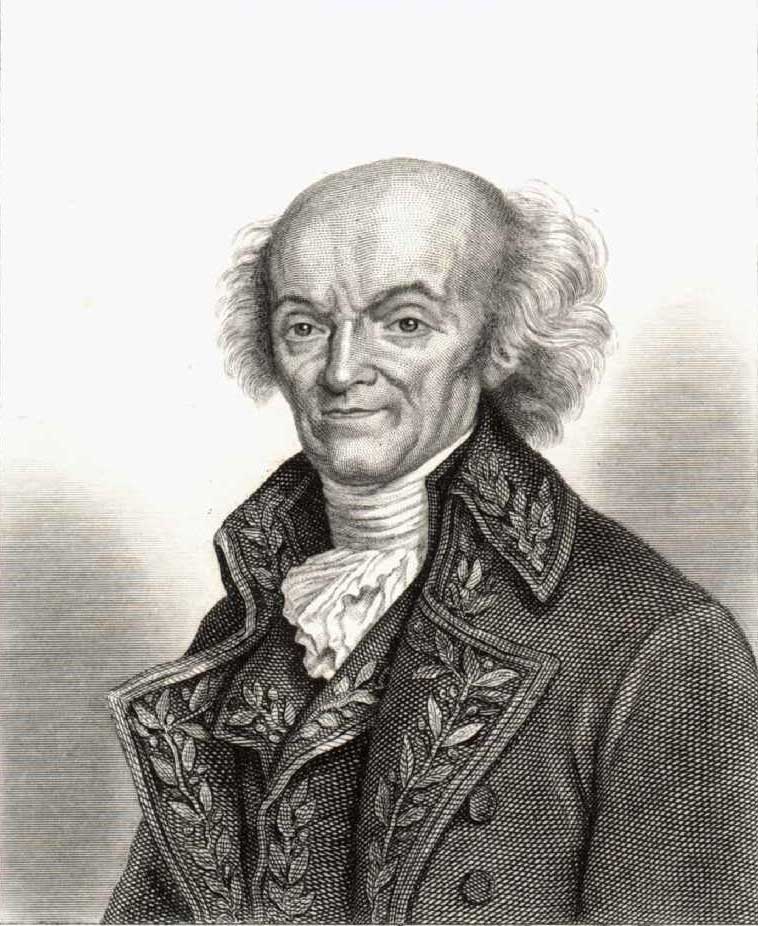.
Jérôme Lalande

Joseph Jérôme Lefrançois de Lalande (11 July 1732 – 4 April 1807) was a French astronomer and writer.
Biography
Lalande was born at Bourg-en-Bresse (now in the département of Ain). His parents sent him to Paris to study law, but as a result of lodging in the Hôtel Cluny, where Delisle had his observatory, he was drawn to astronomy, and became the zealous and favoured pupil of both Delisle and Pierre Charles Le Monnier. Having completed his legal studies, he was about to return to Bourg to practise as an advocate, when Lemonnier obtained permission to send him to Berlin, to make observations on the lunar parallax in concert with those of Lacaille at the Cape of Good Hope.
Quarter of a circle used by Jérôme de Lalande to measure the distance between the earth and the moon in 1751.
The successful execution of this task obtained for him, before he was twenty-one, admission to the Academy of Berlin, as well as his election as an adjunct astronomer to the French Academy of Sciences. He now devoted himself to the improvement of the planetary theory, publishing in 1759 corrected edition of Edmond Halley's tables, with a history of Halley's Comet whose return in that year he had helped Alexis Clairaut to calculate. In 1762 Delisle resigned the chair of astronomy in the Collège de France in Lalande's favour. The duties were discharged by Lalande for forty-six years. His house became an astronomical seminary, and amongst his pupils were Delambre, Giuseppe Piazzi, Pierre Méchain, and his own nephew Michel Lalande. By his publications in connection with the transit of Venus of 1769 he won great fame. However, his difficult personality lost him some popularity.
Although his investigations were conducted with diligence rather than genius, Lalande's career was an eminent one. As a lecturer and writer he helped popularise astronomy. His planetary tables, into which he introduced corrections for mutual perturbations, were the best available up to the end of the 18th century. In 1801 he endowed the Lalande Prize, administered by the French Academy of Sciences, for advances in astronomy. Pierre-Antoine Véron, the young astronomer who for the first time in history determined the size of the Pacific Ocean from east to west, was Lalande's disciple.[1]
Near discovery of Neptune
Main article: Discovery of Neptune
In February 1847 Sears C. Walker of the U.S. Naval Observatory was searching historical records and surveys for possible prediscovery sightings of the planet Neptune that had been discovered the year before. He found that observations made by Lalande's staff in 1795 were in the direction of Neptune's position in the sky at that time and that Neptune might appear in the observation records. On 8 May and again on 10 May 1795 a star was observed and recorded with uncertainty noted on its position with a colon, this notation could also indicate an observing error so it was not until the original records of the observatory were reviewed that it was established with certainty that the object was Neptune and the position error between the two nights was due to the planet's motion across the sky.[2] The discovery of these records of Neptune's position in 1795 lead to a better calculation of the planet's orbit.[3]
Awards and recognition
In 1765, Lalande was elected a member of the Royal Swedish Academy of Sciences.
The crater Lalande on the Moon is named after him.
A high school in Bourg-en-Bresse is named after Lalande. This high school was awarded the Médaille de la Résistance in recognition of the wartime conduct of its teachers and pupils, a unique case among all schools in France.
See also
Les Neuf Sœurs
Felis (constellation)
Quadrans Muralis
Atlas Coelestis
Notable works
Traité d'astronomie (2 vols., 1764 enlarged. edition, 4 vols., 1771–1781; 3rd ed., 3 vols., 1792)
Histoire Céleste Française (1801), giving the places of 47,390 stars
Bibliographie astronomique (1803), with a history of astronomy from 1780 to 1802
Astronomie des dames (1785)
Abrégé de navigation (1793)
Voyage d'un français en Italie (1769), a valuable record of his travel in 1765–1766.
Voyage en Angleterre (1763) Diary of a Trip to England (English translation 2002)
He communicated more than one hundred and fifty papers to the French Academy of Sciences, edited the Connoissance de temps (1759–1774), and again (1794–1807), and wrote the concluding two volumes of the 2nd edition of Montucla's Histoire des mathématiques (1802).
References
Wikimedia Commons has media related to: Jérôme Lalande
Wikisource has original works written by or about: Jérôme Lalande
^ Seymour Chapin, The Men from Across La Manche: French Voyages, 1660-1790
^ Fred William Price (2000). The planet observer's handbook. Cambridge University Press. p. 352. Retrieved 2009-09-11.
^ "USNO - Our Command History". U.S. Navy. Retrieved 2009-09-11.
Mémoires de l'Institut, VIII (1807) (JBJ Delambre)
J-B Delambre: Histoire de l'astronomie au XVIIIe siècle, p. 547
Magazin encyclopédique, II, 288 (1810) (Mme de Salm);
JS Bailly, Histoire de l'astronomie moderne, t. III, (ed. 1785)
J Mädler: Geschichte der Himmelskunde II, 141
R Wolf, Geschichte der Astronomie
JJ Lalande, Bibliographie astronomique p. 428
JC Poggendorff, Biographisch-lit. Handwörterbuch
Maximilien Marie: Histoire des sciences mathématiques et physiques IX, 35.
Jérôme Lalande at the Mathematics Genealogy Project.
This article incorporates text from a publication now in the public domain: Chisholm, Hugh, ed. (1911). Encyclopædia Britannica (11th ed.). Cambridge University Press.
Retrieved from "http://en.wikipedia.org/"
All text is available under the terms of the GNU Free Documentation License

